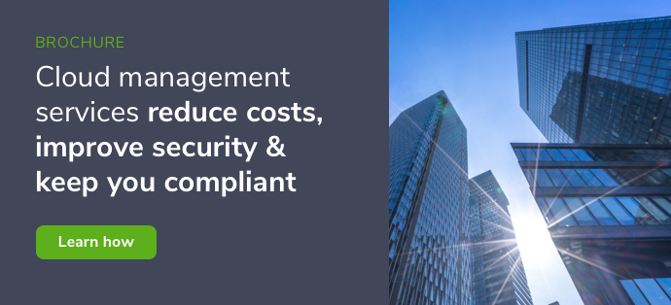Migrating to the cloud is an investment in your enterprise infrastructure. It costs money, which is why cost optimization is so important to cloud management.
But costs are affected by many factors and optimizing a few of them can help lower how much you’re spending. Plus, they provide extra benefits to your cloud infrastructure that will have long term positive impacts.
A well-managed cloud provides security, speed, and improved productivity that comes with the cloud’s flexibility and scalability.
Benefits Of A Well-Managed Cloud
Transparency
Transparency is the greatest benefit a well-managed cloud provides. It enables enterprises to reduce their costs and ensure better security by being able to see the whole picture. Enterprise-level environments are large and often multi-cloud. This makes transparency a serious challenge. A cloud environment that’s logically and effectively managed, with the right tools in place makes transparency a reality.
Security
Management is synonymous with having an overall view of the situation. And when it comes to security, this gives you greater control over critical points of access to your cloud. This makes security easier to manage. It also allows you to make better use of the security tools available from your cloud service provider (CSP).
Operational Agility
Optimized clouds take all the established benefits of cloud computing and turn them into practical assets. They’re primed for scalability and accessibility from the outset, allowing your teams or your customers to experience the benefits of services and workspaces on the cloud.
Robustness & Reliability
No matter how well you prepare and look after your IT infrastructure, things can still go wrong. But effective contingency planning and disaster recovery help you bounce back when disaster strikes. Whether that’s from a failure to meet business needs or customer demands, or in response to service disruptions.
You Can’t Just Pay For An Effective Cloud
The cloud provides everything a growing enterprise wants from an IT infrastructure – scalability. It gives you the capacity for anything at the speed of thought. No need to order in more hardware, just spin up an instance and off you go.
This infrastructure opens the possibility to create new applications that can handle all new challenges. But throwing money at the cloud isn’t the solution to an effective cloud environment. Here are 5 ways effective management can improve your cloud before you start worrying about optimizing costs.
1. Lay Down The Rules Of Engagement
The cloud allows enterprises to automate and test on-demand, and they’re built to take advantage of this. It allows your IT teams to take advantage of innovations without having to rebuild everything from the ground, up.
Creating policies means your IT teams will have fewer issues to fix, which frees them up to do more important things. Failing to do so can lead to idle resources, security liabilities and a general loss of oversight. But ensure your policies don’t create project inertia and undermine the very benefit of the cloud in the first place.
To create cloud policies, you need total visibility over your cloud environment so you fully understand what assets your company has deployed in the cloud and how they are being used. From there, you can devise policies. Common cloud policies include:
- Financial Management Policy
- Rightsizing Policy
- Performance Management Policy
- Security Policy
2. When It Comes To Storage, Use The Whole Buffalo
Most cloud vendors offer a variety of storage options, so use them. No single storage option (say, AWS’s S3 buckets) is ideal for every situation. Utilizing a variety of cloud storage options increases overall cloud performance and can even provide long-term cost savings.
Assuming you cleaned up your storage during your cloud migration, you can further optimize your storage by considering performance, retention and access patterns.
- Performance
Locality can directly influence the performance of your data. Users need content pushed to them quickly so they can do their jobs or use your application.
For example, a popular application with global utilization (like your employee time-tracking application), would be best stored in a multi-regional location. This can potentially bring the content closer to your end-users, enhancing your overall availability. Or, if you need to target specific places, choose a specific region that your data will reside in, and get guaranteed redundancy within that region.
- Retention
Part of optimizing capacity is asking yourself “Why is this object valuable?” and “Will it be valuable tomorrow?” These questions help determine the lifecycle of the storage you need so you can tag it accordingly. When the lifecycle comes to an end, you know to shut it down and not waste any of your storage.
- Access
When we talk about rightsizing cloud environments, the issue of access comes up a lot. The elasticity of the cloud allows you to optimize not just for performance, but for storage too. Understanding how often and by what means users are accessing your data can help you control the amount of storage you have, which in turn, helps reduce costs.
3. Don’t Silo Security
Don’t just rely on your CSP for security. They’ll only look after their data centers, not your data. Instead, integrate security principles throughout your cloud environment. A cloud that’s designed well has security at every layer, providing a more robust and resilient architecture.
Just like policies, your security shouldn’t hinder cloud performance or user experience. It’s a difficult balance to strike, but vital for the secure growth of your infrastructure.
4. Get The Right Skills For The Job
Understanding the cloud is hard. Taken as a whole, a cloud is a complex mix of components, connections, resources, and services. It’s important to understand how all of these elements interact with one another because a change in one component can result in changes elsewhere.
If you try and muddle through without understanding how the cloud works, you run the risk of creating an unstable architecture with unexpected costs and performance issues.
5. Be Open To Sharing
Cloud providers' performance varies wildly and it’s not easy to measure. So much depends on exactly which cloud configuration you use and your workloads. Some enterprises benefit from building applications with a close relationship to one CSP, but more often, we’re seeing an increase in a multi-cloud approach.
Multi-cloud strategies are more complex, but effectively they give you the best of all the CSPs, without the weaknesses that come with a single dependency.
Struggling to Manage Your Cloud?
We understand that monitoring a complex cloud environment can be a major challenge. That’s why we offer complete peace of mind with our Cloud Management service.
We ensure your cloud environment is proactively monitored and risks are managed by a team of cloud security experts. We subject your cloud to over 550 best practice checks, so you can be confident in the security of your enterprise. Download our brochure for more information.
Topics: Cloud Management Services


